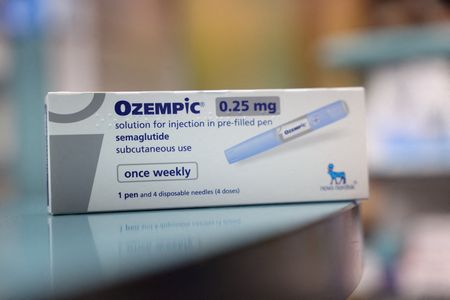By Michael Erman
NEW YORK (Reuters) – Now that the U.S. government has negotiated prices for some Medicare program drugs effective in 2026, Wall Street analysts are betting on a 2027 list that will include Novo Nordisk’s blockbuster Ozempic for diabetes and have a limited impact on Big Pharma.
Other possible 2027 candidates include Pfizer’s cancer drugs Ibrance and Xtandi, GSK’s asthma and chronic obstructive pulmonary disease (COPD) treatment Trelegy Ellipta, Teva’s Huntington’s disease treatment Austedo and Abbvie’s irritable bowel syndrome drug Linzess, according to five analysts as well as researchers and company executives.
The drugs, which have been on the market since at least 2017, are among those that the Medicare health program spends the most on for people aged 65 and older or with disabilities. Regulators are due to announce the list of 15 more drugs by February of 2025.
Under President Joe Biden’s signature Inflation Reduction Act (IRA), prices for 10 highly popular prescription drugs used by Medicare will be cut by 38% to 79% in 2026. The industry has fought the negotiation program, saying it will stifle innovation.
Government researchers predict that the use of diabetes drug Ozempic for weight loss would raise the U.S. deficit over the next 10 years at its current price. Medicare spent over $4.6 billion on the drug in 2022.
Bristol Myers’ Pomalyst and two other Abbvie drugs, Vraylar and Venclexta, may also be up for negotiation in 2027, analysts said.
“We are proud of the 10 agreements reached to bring new, lower prices to people with Medicare,” a U.S. Department of Health and Human Services spokesperson said in an email. “The Biden-Harris Administration will continue using every lever at our disposal to bring down costs for the American people.”
MANAGING THE FINANCIAL IMPACT
Analysts, investors and some executives said many of the 2027 candidates are already heavily discounted or set to lose their patent protection soon after the new prices take effect. “The headline number for percentage discount initially may be fairly high,” said Dan Lyons, portfolio manager for health care and biotech at Janus Henderson Investors. However, the actual impact on the companies’ bottom lines may be more manageable than expected, he said, noting that the market has already priced that into the drugmakers’ stocks.
The law appears to have “more bark than bite,” at least for the first few years, said BMO Capital Markets analyst Evan Seigerman.
He noted that the negotiated cuts are based on the gross price and do not reflect after-market rebates or discounts the drugmakers had already been giving.
“You won’t see much of an impact, especially for these highly rebated products – and most of them are,” said Seigerman, who includes Ozempic in the list of highly discounted products facing price negotiation.
Novo has said it retains around 60% of Ozempic’s list price.
Novo executives said on the company’s conference call earlier this month it was too soon to know the impact on Ozempic.
At least two Pfizer drugs, Ibrance and Xtandi, could be on the 2027 list. U.S. patents for both cancer drugs expire that year and Pfizer executives have estimated a muted financial impact, while disagreeing with the government’s broad price setting.
“The timing of patent exclusivity on those medicines leads us to believe that we will find a way to manage this,” Pfizer Chief U.S. Commercial Officer Aamir Malik said in an interview.
Teva CEO Richard Francis said his company’s forecasts for Austedo include a potential price cut under the Inflation Reduction Act and that the company is nonetheless projecting growth for the Huntington’s disease treatment.
It has forecast full-year earnings of $2.5 billion for Austedo in 2027, up around 25% from what analysts forecast for the drug in 2026 according to LSEG data.
Abbvie CEO Robert Michael said last month that even modeling in the long-term impact of drug price negotiations, the company expects to deliver on its long-term outlook. GSK declined to comment.
2028 CUTS
In 2026, regulators will announce up to 15 more drugs to be negotiated for 2028, including those covered by Medicare’s hospital program known as Part B and up to 20 more drugs for each year after that.
The Congressional Budget Office, which does nonpartisan research for U.S. Congress, has forecast that the government will save $9.4 billion the following year from the price negotiations, up from $6 billion this year.
Future negotiations may not include such heavily discounted drugs as for 2026, particularly after Part B drugs are selected in 2028, said Inmaculada Hernandez, a professor at University of California San Diego, in an email. “Traditionally, provider-administered products have less discounts than drugs dispensed by pharmacies.”
(Reporting by Michael Erman; Additional reporting by Deena Beasley and Bhanvi Satija; Editing by Caroline Humer and Richard Chang)





